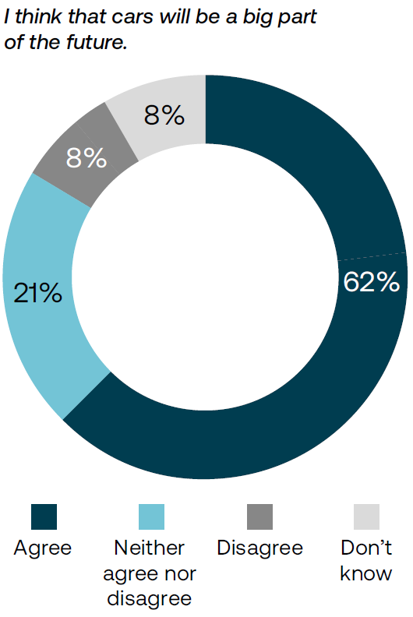Electrification of cars, connectivity, and the development of fully autonomous vehicles were set to upend the automotive industry, it was said. Looking back, the transportation demands and behaviours of today look very similar to previous generations.
Do we dare to make more predictions?
To begin with, bold predictions are not new. Around the turn of the 19th century, the imagined vision of the future of transportation was utopian. The 20th-century man imagined a future where speed and technology had made immense advancements. The film “Back to the Future” (1985) even dismissed the need for roads altogether, with Doc Emmett Brown's famous line “Where we’re going, we don’t need roads” becoming an instant classic.
While being a family sci-fi film, the film was of its time. Innovative concepts such as hovercrafts, personal jetpacks, and even Maglev trains were developed by the private sector.
What history and recent studies show us
However, it seems people’s perception and need for mobility have not changed much in the modern era. Even with the push towards innovation, the same core issues and preferences continue to dominate, Tesla-founder Elon Musk concludes. This is also confirmed in the report you are reading right now. The long-lasting love story with cars is reaffirmed, connected to the timeless values they bring, such as flexibility and comfort.
This notion suggesting that the underlying dynamics have remained largely unchanged is reinforced by several reports from recent times. While some trends and emerging technologies are undeniable, some underlying forces and dynamics have “kept the essential characteristics” the same up to this day, according to the consulting firm McKinsey (2021). In a report from 2021, the advisory firm BCG concludes that “consumer inertia and slow regulatory movements” have been constants throughout time.
Trends that have gone cold – and one that is still hot
However, there are undoubtedly smaller and transformative things happening beneath the surface. A decade ago, there were three major trends:
- Connectivity
- Self-driving cars
- Electrification
Only electrification has kept up the pace, according to Oskar Gibas Hjertquist, Head of International Sales at MEKO. He notes that many politicians and businesses linked to the industry are keen to talk about electrification. Climate change, the Paris agreement, and consumers' wish to play their part in the transformation obviously add to this.
“Predicting the pace of electrification is difficult, mostly due to dependency on politics and policy” says Oskar Gibas Hjertquist. “Trade wars, the introduction of tolls on electric vehicles are two things that come to mind. What would moving the power center from the US and Europe to China mean for production? Will we see cars with other features? Maybe.”
One important clue about the future of mobility
However, there are more clues that shed light on the future, apart from underlying preferences that seem to be preserved over time. The mobility organization SAE International (2020) concluded that today’s technology and digitalization experience barriers – regulatory, technological, and societal acceptance. These obstacles are “reminiscent of those faced by any transformative technology in history,” which would mean a slow transformation.
Speaking about consumers' concerns of today relating to electric cars, however, Oskar Gibas Hjertquist is not as worried. “Battery technology will continue to improve,” he says.
“Future generations of batteries will be more reliable, more sustainable, and cheaper. We have seen issues with early generation batteries and some predict that batteries will always stop working after ten years, but that’s not my perception. Batteries may even outlast the vehicles and carry value in the aftermarket in the future.”
New mobility technology is hindered by humans – and regulations
What about connectivity and autonomous driving – two trends that were burning hot a few years ago? Consensus seems to be that the most significant changes will encompass new AI innovations, but that the driver seat will continue to be occupied by humans.
Dr. Sven Beiker, an automotive expert and lecturer at Stanford University, reflects that the promise of autonomous vehicles has been a “decade-long dream, yet practical deployment reflects the complex nature of societal and regulatory acceptance.” A report from the global market research company Technavio (2024) adds to this, stating that the fundamentals of automotive consumer behaviour are taking longer than expected to shift. This report also confirms that 80 percent of people trust a human driver more than a computer.
So, what does the future hold?
“While tech can be transformative, it is in the end consumers’ preferences that shape the direction,” says Oskar Gibas Hjertquist. “I don’t see this happening in the coming decade without outside help. There would have to be a regulative catalyst to revive those technologies, with implementation in some confined areas. Looking at the predominantly rural areas in the Nordics, my bold prediction is that things will be very much the same in ten years.”
One thing is clear, at least according to the majority of the people in Sweden, Norway, Denmark, and Finland: cars are here to stay. 62 percent believe cars will play a significant role in the future, up from 59 percent last year — marking the highest level of support since the Mobility Barometer launched in 2022. Only 8 percent think cars won’t play a major role, down from 10 percent in 2023. This is the lowest level recorded.







